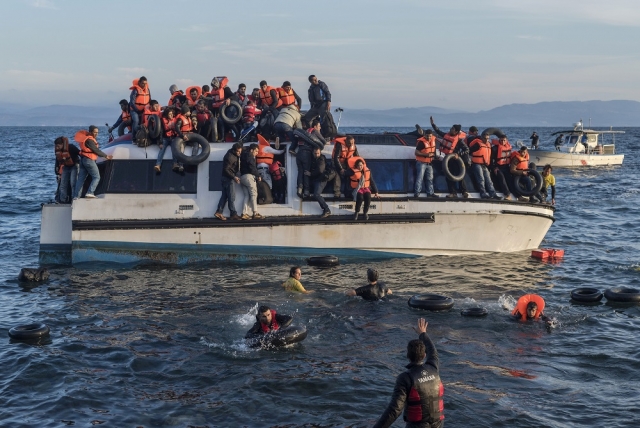The equivalent of a silent, unilateral war has been going on for years in the Mediterranean Sea. It is not a war in the traditional sense, because it lacks contending armies, but a war of the entrenched 'civilised world' against hundreds of thousands of unarmed people. Their only crime is a desperate attempt to flee poverty, unbearable living conditions and the destruction of their livelihoods in their home countries, and follow the dream of a better life for themselves and their families in Europe.
Over the last 15 years, 30,000 men, women and children have lost their lives drowning while attempting to reach European shores. And each year the number of victims is rising.
Still, many more are succeeding and entering Europe through the routes that lead to the shores of Greece, Italy or Spain. Many others are stopped on the way, before they can even make it, or caught at sea before they can reach international waters, and brought back and imprisoned in concentration camps in inhumane conditions in Turkey, Libya or Morocco. These unfortunates wait for months for something to happen, while many die of privations and easily curable diseases.
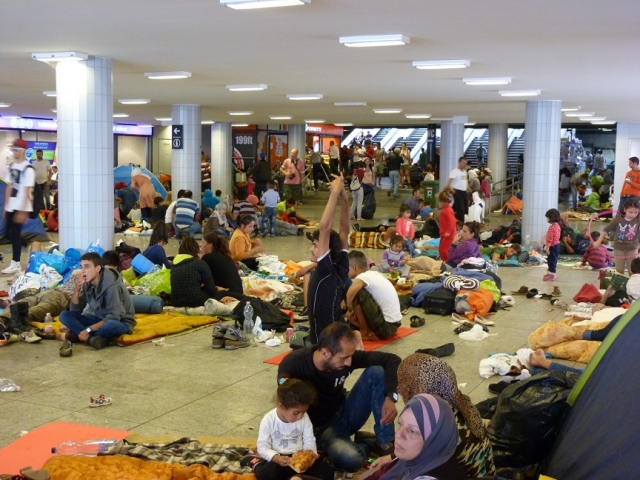 Migrants at the Budapest Keleti rail station / Photo: Wikimedia Commons
Migrants at the Budapest Keleti rail station / Photo: Wikimedia Commons
Many more disappear en route across the desert, or are enslaved by human traffickers in Libya and held so they can work in exchange for a passage on the traffickers’ boats. Women are often forced to prostitution, and men, women and children are beaten, brutalized and killed by the criminals who profit from human trafficking, but also by the armies, police, border and coast guards of the countries they have to cross. All this occurs with little or no scrutiny by the so-called international community.
No one really knows how many people are actually losing their lives or are unaccounted for, because no one is in a position to control what is happening in large swathes of territory that are controlled by criminal gangs and warlords.
While this tragedy is staged night in and night out, the European governments are playing their usual cynical game of bouncing responsibilities between eachother. They shed crocodile tears about this immense tragedy, presenting it as if it were a natural disaster that they have nothing to do with. Like imperialist meddling or direct intervention had nothing to do with the Syrian war, or the Saudi war against Yemen, or the destruction of the Libyan state, or the many conflicts that are afflicting the peoples of sub-Saharan Africa.
Deaths in the Mediterranean Sea have reached an all time peak in the course of the last 12 months. The latest figures published in September by the UN Refugee Agency estimate that 4,337 people have drowned since the same month of 2016 while attempting to reach Europe, mostly from the coasts of Libya. The figure for the previous 12 months displayed already a tragic death toll of 4,185. However, we should bear in mind that these figures only account for what is known; the real death toll may be substantially higher.
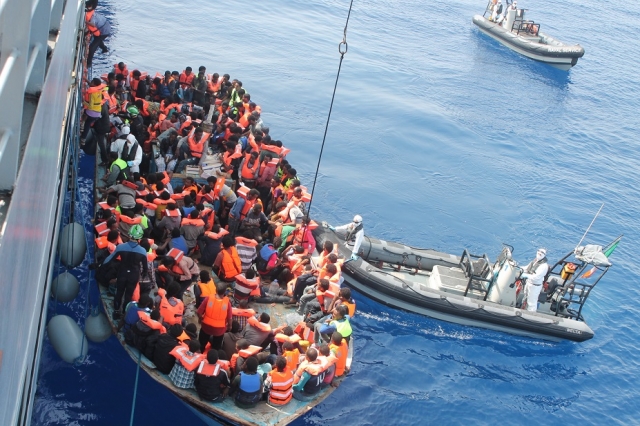 Thousands of migrants have died at sea / Photo: Wikimedia Commons
Thousands of migrants have died at sea / Photo: Wikimedia Commons
The cause of this wave of immigration and refugees is not hard to find. It is the result of the general instability into which one country after another in the Middle East and North and sub-Saharan Africa have been plunged. In some cases, direct military intervention by European and Western imperialist powers and their allies and proxies have contributed heavily to the chaos.
This is not just provoking an increasing influx of people trying to flee inhumane conditions, but also providing the breeding ground for criminal organisations and local warlords who are set to profit from human trafficking.
The looting of Africa
Imperialist exploitation of African natural resources (both under direct colonial rule and the post-colonial regimes up to the present day) has drained revenue and profits out of continent and undermined the livelihoods of millions. Unequal terms of trade have destabilised weaker economies, ruining local farming and small workshops.
Systemic corruption of the local elites – who are taking a slice of the loot – has become the prevalent means by which the imperialists ensure their interests of are catered for. As an indicator of the African elites’ participation in the imperialist looting of Africa: a 2014 study estimated that rich Africans were holding $500 billion in tax havens, while the majority of the population is plunging into poverty.
But that alone would not be enough to explain the level of damage caused by imperialist domination. Competition between rival imperialist powers for influence, resources and markets underlies countless coups d’état, conflicts and civil wars raging in the continent and beyond.
But it is not just war that millions of people are fleeing from: it is poverty and the general worsening conditions of life. The European governments’ hypocritical attempts to justify their present repressive immigration policies by introducing an artificial distinction between “legitimate” political refugees (escaping war and oppressive regimes), from alleged “illegitimate” economic migrants, is nothing short of a travesty.
“Fortress” Europe
The daily death toll at sea hardly makes headlines, except when the tragedy becomes simply too great to be completely ignored. This occurred in May 2017, when in two separate incidents on the same night, two boats capsized and 210 people drowned. Similarly, on 11 October 2016, distress calls coming from a sinking boat with 260 people on board were wilfully dismissed by the Italian coast guard, whose patrol boat Libra was just a few miles away, waiting for an order to intervene. The reason for the delay was a dispute with the authorities of Malta over who should intervene. Dozens of refugees drowned as a result. Recordings of their distress calls, revealing the dismissive attitude of the Italian authorities, were then leaked to the Italian magazine L’Espresso, causing a major scandal.
What has happened since the 2015 refugee crisis, when hundreds of thousands of people determined to reach Europe through Turkey and Greece walked their way through the Balkans in order to reach Hungary, Austria, and eventually Germany? Angela Merkel’s promise to welcome the Syrian refugees was promptly forgotten. A few months later, in March 2016, the EU signed a deal with Turkey, which meant that all refugees (including asylum seekers) reaching the Greek soil would be automatically sent back to Turkey.
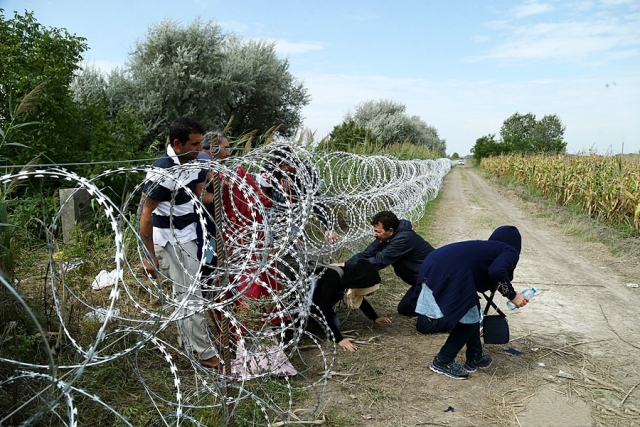 Fortress Europe / Photo: Wikimedia Commons
Fortress Europe / Photo: Wikimedia Commons
Human rights organisations have – to no avail – denounced the deal as breaking both European law and the UN Refugee Convention. What this shows is that international ‘legality’ is twisted to suit the interests of the powerful, regardless of the human cost. In exchange, the EU promised to give €6 billion to the Turkish government, allegedly to support the estimated 2.7 million Syrian refugees in Turkey at that time.
Even by effectively closing down the Aegean route, the European governments have not stopped immigration. What they have achieved is to make more difficult and dangerous routes – like the one across the desert through Libya, or through Morocco – the only options.
There is no way that immigration can be stopped. Considering the official figures released by the UN, which puts the amount of refugees worldwide at over 65 million, only a minimal proportion is even attempting to make their way to Europe. Among the global refugee population, there are 5.3 million Syrians in Lebanon, Jordan, Turkey, Iraq and Egypt. Turkey has more than three million, Lebanon over one million.
These refugees have been trying to remain as close to their homes as possible, hoping to return at some point. In the meantime, their status in the countries hosting them is uncertain. They are not allowed to work legally and most of them have no income, little or no access to the local healthcare system, and almost no access to education for their children. They see little money other than the occasional international aid contributions, and are eating into their savings.
After seven years of war in Syria, more and more refugees are abandoning the idea that there is something they can go back to and are attempting in increasing numbers to make their way towards Europe. A similar process is happening everywhere there are large populations displaced by war, famine or other calamities.
Scenes of dozens or hundreds of overcrowded, shaky vessels and dinghies, full of scared, hungry, dehydrated men, women and children, venturing from the Libyan coast in the dark into the open sea, epitomise the migrants’ ordeal. Thousands of people are collected from these boats by the Italian or Greek coast guards or by the many NGOs that have filled in the vacuum left by the European authorities’ decision to withdraw from search and rescue missions in international waters. This decision has led immediately to a sharp increase in the death toll at sea.
Amnesty International has denounced the deadly consequences of these policies in a report published last July (A perfect storm: The failure of European policies in the Central Mediterranean). By ceding the lion’s share of responsibility for search and rescue to NGOs and by increasing cooperation with the Libyan coastguard, European governments are willingly increasing the deaths at sea and turning a blind eye to abuse the immigrants that are sent back to Libya are subject to, including torture and rape.
“European states have progressively turned their backs on a search and rescue strategy that was reducing mortality at sea in favour of one that has seen thousands drown”, commented John Dalhuisen, Amnesty International’s European director.
Instead, EU governments have shifted their focus to “regulating” the influx of immigration and “destroying the smugglers’ business model” – hypocritical euphemisms for harsher repression, tougher border controls and pouring money and resources into the Turkish, Libyan and Moroccan authorities for blocking immigrants before they dare to enter Europe. This failing strategy has led to a threefold increase in the death-rate from 0.89% in the second half of 2015 to 2.7% in 2017.
Libya – a failed state
What is happening in the Mediterranean is the graphic illustration of the sickness of capitalism. But it is only the tip of the iceberg. Thousands die en route even before they reach the coast of Turkey or North Africa.
Those rescued at sea by the Libyan coast guard in Libyan territorial waters are brought back to Libya. They are regarded as illegal immigrants and imprisoned in corrugated-iron warehouses, exposed to the heat, in subhuman conditions, without medical assistance, deprived of water and food, brutalized by guards who are at best unprepared to deal with these conditions, and simply forgotten.
According to an account by Italian journalist, Francesca Mannocchi, in February 2017, the official detention centre “Garian” in Tripoli hosted 1,400 people (250 children) distributed in 15 warehouses. She reported that there was not even enough floor space for people to lie down and sleep, poor sanitary conditions and scarce water and food – and these were the conditions of an official detention centre.
Britain, France and the USA claimed hypocritically that there were humanitarian reasons for their bombing campaign against the Gaddafi regime in 2011. But since the collapse of the regime, Libya has been plunged into chaos, with rebel militias loosely aligning with rival governments, or operating on their own and carving out fiefdoms under their direct control. The collapse of state control and enforcement of borders made Libya the ideal base for all types of trafficking. By blocking the way through Turkey and Greece, the Libyan route has opened up and became the only possible option for African migrants. Warlords and local militias have become more and more reliant on smuggling as a revenue source.
It is estimated that 200,000-300,000 African immigrants are at present in Libyan territory. They are vulnerable to abuse, whether they are working in Libya, held in slave-like conditions, or waiting for a chance to get a passage to Europe.
Armed groups often detain migrants, pretending to be enforcing the law but in reality just to extort money or labour in exchange for a passage on one of their boats. They run their own detention centres without answering to the so-called central authorities. It is estimated that 50 percent of the Libyan coast’s GDP is connected with the smuggling operations.
Immigration scaremongering
Those who make it through and are intercepted in international waters are then sent to Europe, to so-called refugee camps (prisons in all but name), mostly in Italy, since the other immigration routes have been closed or made more difficult over the past years. There they stay, waiting for their applications to be processed, or for expulsion.
Many then try to make their way towards the wealthier north and reach relatives in Germany, France, Austria, Sweden or other Northern European countries, but are blocked at the Italian border by the Austrian or French border police and thrown back.
The influx of refugees cannot be stopped. Every single measure taken to block it (or 'regulate' it) has led to higher death tolls, more dangerous and expensive routes, and a strengthening of the human traffickers’ organisations.
While shedding false tears about the human tragedy of the immigrants, the European ruling classes are generally moving towards a more repressive stance on immigration, while promoting a scaremongering campaign in the media in order to further counter-reforms and mobilise the poorest sections of society in support of a reactionary agenda.
The main thrust of this campaign is an attempt to exploit the shock created by the recent years’ terrorist attacks in Europe to build links between Islamic fundamentalist terrorism and immigration, as part of a general racist and islamophobic campaign and the reactionary defence of 'Christian' or 'European' values.
Another line of attack is that foreign workers, regardless of their religion or origin, are blamed by the bourgeois mainstream media for what in reality are effects of the capitalist crisis: declining wages and working conditions, rising unemployment and underemployment, falling living standards and the lack of affordable housing.
“There is not enough for everyone”, is the mantra, while the European capitalist elites get richer and richer.
Immigrant workers fight back
The reason for this slander and misinformation is always the same. The capitalists need immigration, but by making integration of immigrant workers into the working class-and their organisations more difficult, they expand the 'reserve army' of unemployed, underemployed and more vulnerable layers of society in order to divide the workers in a competition for survival of the poor against the poor.
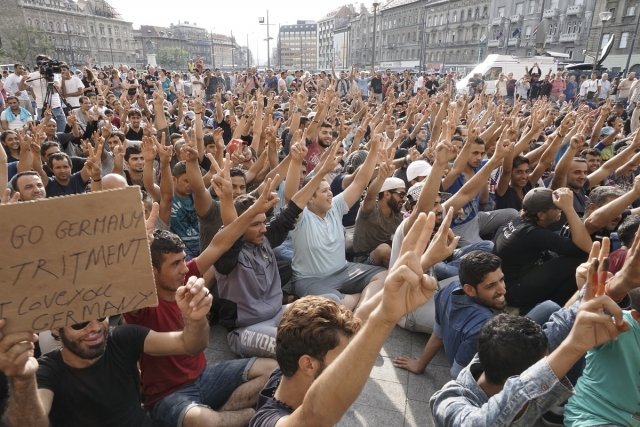 Prottesting migrants demand entrance to Germany / Photo: Wikimedia Commons
Prottesting migrants demand entrance to Germany / Photo: Wikimedia Commons
Immigrant workers, of both legal and especially illegal status, are often providing the bulk of the labour force in sectors like agriculture, with wages and conditions driven down by extreme levels of blackmail.
But inevitably this section of the working-class is organising and fighting back, as has been shown in the many struggles of immigrant workers in Southern Italy over the past several years.
The denunciation of the traditional caporalato system for day labourers in agriculture (bosses’ thugs who every morning collect the labourers and decide who gets the work and for how much) has revealed appalling conditions even for legal immigrants coming from poorer EU countries like Bulgaria or Romania.
These workers are often subject to semi-slave conditions and abuse, with their documents withdrawn and held by their exploiters. Daily work shifts of 12-14 hours under the scorching heat in the summer for 10-15 Euros are not uncommon.
These conditions are fuelling a rising militancy on part of the immigrant workers. In January 2010, hundreds of African orange-picking seasonal workers revolted against the constant threats from organised crime, after some of them were shot at. They fought back and stormed the town of Rosarno in Southern Italy, armed with sticks and stones, or bare hands.
Again in 2010, there was the agricultural daily labourers’ strike in Castelvolturno. Workers gathered in the pick-up points and crossed arms demanding better conditions, defying all threats. A similar strike developed the following year in the Salento area of Apulia, when workers deserted the gathering points for days. By 2015 about 50,000 out of the 160,000 daily workers in agriculture conquered a regular contract, but the struggle is far from won.
Over the past decade more and more immigrant workers have been entering the ranks of the working-class in the factories and other sectors and have been gaining confidence in their ability to organise and defend their rights. Strikes in the logistics and building industry, and many other sectors, show the participation of a rising number of immigrant workers.
As the class struggle radicalises throughout the continent we will see the impact of the struggle of immigrant workers on these same workers’ own consciousness and on the consciousness of the whole of the working-class. These proletarians will gain confidence in their strength when mobilising in unison, challenging not just the conditions they are forced to live in, but the very foundations of the system that is creating these conditions: that is capitalism.

